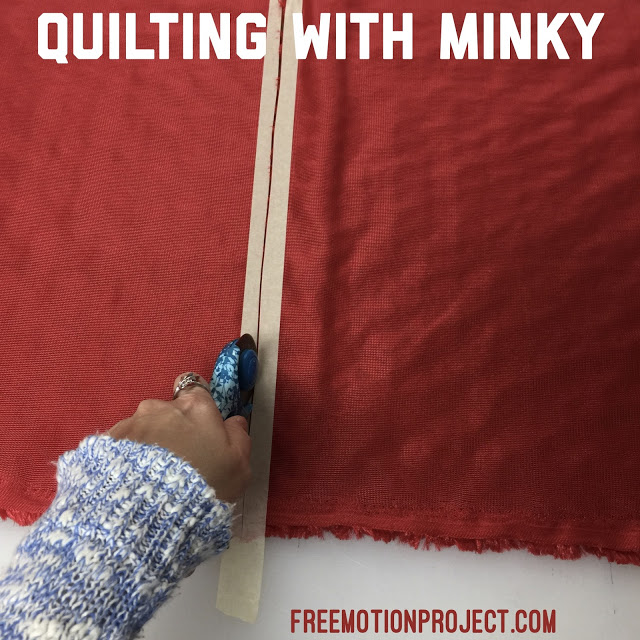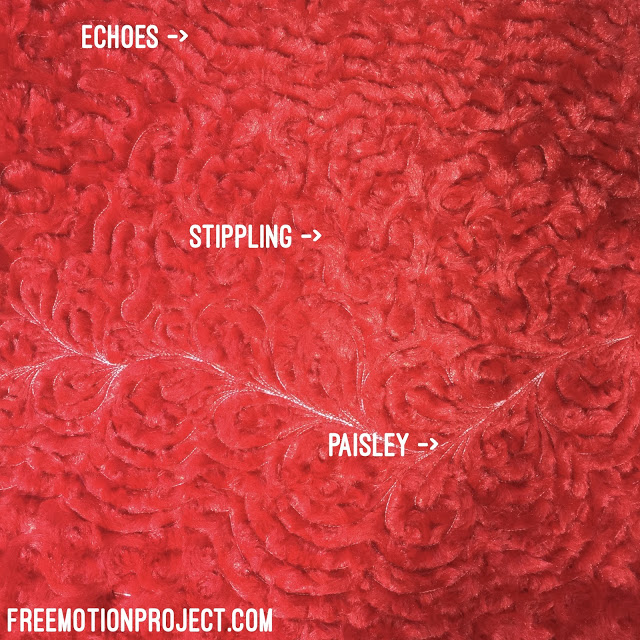How to Quilt with Minky Fabric
This week I’ve been playing with Minky fabric on the back of several quilt sandwiches and I love the effect. Learn how to quilt with Minky fabric and machine quilt Paisley in this new Sit Down Quilting Sunday video:
 Thoughts on Quilting with Minky Fabric
Thoughts on Quilting with Minky Fabric
I really enjoyed quilting with Minky fabric. Honestly it was a lot easier than I expected. I’ve been intimidated by Minky for years, but once I got it basted up it really wasn’t hard to quilt over.
The hardest part was cutting the Minky fabric which made a huge mess! At the store, the clerk cut it and ended up with red fluff all over her shirt, the table, and the floor. I felt bad because I had no idea Minky was such a messy fabric to cut.
I shoved it deep in a plastic bag and warned my piecer that it was going to be a big mess so we were both prepared. We ended up cutting it with masking tape and that significantly reduced the mess.

We taped off the area we wanted cut out, then cut through the middle of the tape, then removed the tape and it took all the cut ends of the Minky with it. I did have to lint roll the tables and my shirt a few times, but it wasn’t nearly as bad as the mess it made in the store.
To stabilize or not to stabilize
I do think stabilizing with some sort of lightweight stabilizer like French Fuse is a good idea. Minky is a stretchy fabric and the French Fuse stabilized the fabric and stopped it from stretching out of shape as I basted all my blocks.
When I quilted with fleece, a lot of quilters commented that they didn’t stabilize at all. That’s fine too! Keep in mind that I tend to quilt densely and whenever I’ve used weird fabrics in a quilt, I’ve always regretted not stabilizing.
I also do like using a batting with Minky fabric. I found on the sample I stitched without a batting, the Minky fluff tended to pull up through the fabric and show on the top. I also liked the drape and feel of the quilt best when fleece was the batting in the middle.
Best Quilting Designs for Minky Fabric
The other thing to consider when quilting with Minky is your quilting design and how that will effect the fluffiness of this fabric. I tested three designs on my practice quilt sandwiches: Stippling, Echoing lines, and Paisley.

On the front, the designs all look great, but on the back…honestly Paisley is my least favorite. That design has a lot of travel stitching which built up over the Minky fabric and showed up through the fluffy pile.
After looking at all of my samples I didn’t really like this thread effect on the back of the quilt. I would stick with open designs that don’t involve any travel stitching like Stippling, Matrix, and Ocean Currents.
What do you think about quilting with Minky fabric? Have you ever backed a quilt with Minky? Please share your experience in the comments below!
Let’s go quilt,
Leah Day

I have never quilted on Minky but I will plan to give it a try after seeing your testing. Have you tried to fluff the Minky with a soft brush to lift fibers sewn down?
My friend quilted with Milner and she loaded it on her frame as the top and put the top as the backing. This kept it from sagging and stretching. I would think starching would help to keep it stable.
I've done a couple quilts with Minky fabric, and actually used it for the binding! I had to experiment with the binding quite a bit, but finally got a method that worked–the Minky fabric actually hid the machine stitching quite well!
Minky binding tutorial here at bottom: http://www.patchworkandpebbles.com/baby-ruscher-quilt/
And a queen-size Minky-backed quilt: http://www.patchworkandpebbles.com/fields-of-flowers-quilt/
Whoa! That's seriously brave to bind with Minky! I'll definitely check out your tutorials Melodie. Thank you for sharing!
I ran my hand over it a bit, but the areas with a lot of thread are pretty squished down. I think more open designs will look best on the back and they will get the quilt quilted quickly.
I prefer to quilt with Cuddle by Robert Kaufman http://www.shannonfabrics.com/ I buy it through a friend as no local quilt store carries it. Easier to work with and I love the colors. I bought a bolt (I got a discount for buying that way, one bolt at a time about 8 months apart) each of french blue, slightly raspberry red (scarlet or red), and gray.. not sure which, but was light. I usually use it as a backing to a cotton pieced top. Quilting designs show up beautifully. That friend uses a long arm, I quilt at my sewing machine.
I prefer Cuddle fabric by Robert Kaufman. I have used it as backing on a number of quilts. I have a friend who long arm quilts and began using it as well. The backs pick up quilt designs beautifully. My last quilt had feathered hearts on it. I'm traveling so I don't have a picture. http://www.shannonfabrics.com/
I used Minky once, for the back of a quilt. Let me just say that was my first go and it will be my last. I am obviously not skilled or knowledgeable enough to comfortably quilt with Minky. I did finish and the quilt recipient loved the quilt but I darn near had a break down during the process. No, I did not stabilize (there's that lack of knowledge). If I ever, ever try this again (highly doubtful), it will be with much more research and practice under my belt. Love what you did Leah. My favorite was the echo quilting on your Minky.
I have been using Minky for my grandkids quilt because it is so soft. The problem I found is the backing sucks in so the back ends up to be smaller than the top. So to solve the problem I buy 1/2 yard extra fabric and I don't make it as wide. I love how they turn out.
I've used mink in once on a quilt back. Didn't like it. It shifted a lot. Might try it again using the stabilizer. Love the way it feels, nice and soft. Hate the mess it makes when you cut it, but will try using the masking tape. Thanks so much for all the tips on using minki.
My stitches sink into the minky and i want them to show. I'm using a 75 needle and have tried all kinds of threads, nothing works! I didn't want to use batting. HELP
Minky is not the right type of fabric to use if you want your stitches to show. Try 100% cotton, or silk or sateen if you're wanting them to really stand out.
I've been wanting to make a throw for my Mother who will be turning 90 in a few months and I think Minky/Cuddle fabric would be great to keep her warm and be so soft. I've been shying away from Minky/Cuddle fabric because of its stretch and how messy cutting it can be (I love how you used tape when cutting. What a great idea). Thank you for telling us about French Fuse stabilizer since I had never heard of it before. Since Minky/Cuddle fabric is supposed to melt from the heat of an iron, is there a trick to ironing the French Fuse to the back of the Minky/Cuddle fabric?
We haven't had an issue with pressing the french fuse on the Minky fabric. I use a pressing cloth – usually a fat quarter of cotton fabric I don't like to cover the french fuse and then press with a hot, dry iron. The key is to test on a small scrap first, figure out what works and go with that!
Thank you for your reply, Leah. Just to clarify, you are pressing the French Fuse (with pressing cloth/fabric in between the iron and the French Fuse) side as opposed to pressing on the MInky (with the pressing cloth/fabric in between the iron and the Minky), right?